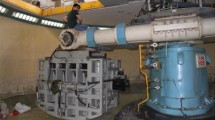Abstract
Two in-flight shear wave velocity measurement systems were developed to perform the subsurface exploration of shear wave velocity in a centrifuge model. The bender elements test and the pre-shaking test used in the study provided reliable and consistent shear wave velocity profiles along the model depth before and after shaking in the centrifuge shaking table tests. In addition, the use of the bender elements measurement system particularly developed here allowed continuous examination of the evolution of shear wave velocity not only during and after the shaking periods in the small shaking events but also during the dissipation period of excess pore water pressure after liquefaction in the large shaking events. The test results showed that the shear wave velocity at different values of excess pore water pressure ratio varied as the effective mean stress to the power of 0.27, to a first approximation. Consequently, a relationship between the shear wave velocity evolution ratio and the excess pore water pressure ratio is proposed to evaluate the changes in shear wave velocity due to excess pore water generation and dissipation during shaking events. This relation will assist engineers in determining the shear stiffness reduction ratio at various ru levels when a sand deposit is subjected to different levels of earthquake shaking.
Similar content being viewed by others
References
Arulnathan R, Boulanger RW, Kutter BL, Sluis WK (2000) New tool for shear wave velocity measurements in model test. Geotech Test J 23(4): 444–453
Brandenberg BJ, Choi S, Kutter BL, Wilson DW, Santamarina JC (2006) A bender element system for measuring shear wave velocities in centrifuge models. In: Proceedings of physical modeling in geotechnics—6th ICPMG, pp 160–165
Corte JF, Garnier J, Cottineau LM, Rault G (1991) Determination of model soil properties in the centrifuge. In: Proceedings of international conference centrifuge 91, Boulder, 13–14 June, pp 607–614
Dyvik R, Madshus C (1985) Lab measurements of Gmax using bender elements. In: Proceedings of advances in the art of testing soils under cyclic conditions, ASCE Geotechnical Engineering Division, Detroit, pp 186–196
Gohl WB, Finn WD (1991) Use of piezoceramic bender in soil dynamic testing. In: Shobha KB, Geoffrey WB (eds) Recent advances in instrumentation, data accquision and testing in soil dynamics, Geotechnical Special Publication No. 29, pp 118–133
Hardin BO, Drnervich VP (1972) Shear modulus and damping ratio in soils: design equations and curves. J Soil Mech Found Div ASCE 98(7): 667–691
Japan Road Association (1996) Specification for highway bridges, Part V, Seismic design
Kim NR, Kim DS (2010) Development of Vs tomography testing system for geotechnical centrifuge experiments. 7th Physical modeling in geotechnics, 7th ICPMG, Springman, Laue and Seward (eds) vol l, no. 1, pp 349–354
Lee CJ, Huang HY (2007) Wave velocities and their relation to fabric evolution during the shearing of sand. Soil Dyn Earthq Eng 27(1): 1–13
Lei F, Zeng X, Figueroa JL (2004) Shear wave velocity measurement in centrifuge using bender elements. Int J Phys Model Geotech 4(2): 1–11
Rammah KI, Ismail MA, Fahey M (2006) Development of a centrifuge tomography system at UWA. In: Ng, Chang, and Wang (eds) Proceedings physical modelling in geotechnics, 6th ICPMG, vol l, no. 1, pp 229–234
Seed HB, Wong RT, Idriss IM, Tokimatsu K (1986) Moduli and damping factors for dynamic analysis of cohesionless soils. J Geotech Eng ASCE 112(11): 1016–1032
Stewwart DP, Randolph ME (1991) A new site investigation tool for the centrifuge. In: Proceedings of international conference centrifuge 91, Boulder, 13–14 June, pp 531–538
Wichtmann T, Triantafyllidis T (2009) Influence of the grain-size distribution curve of quartz sand on the small strain shear modulus Gmax. J Geotech Geoenviron Eng ASCE 135(10): 1404–1418
Zeng X, Ni B (1999) Stress-induced anisotropic Gmax of sands and its measurement. J Geotech Geoenviron Eng ASCE 125(9): 741–749
Zhou YG, Chen YM (2005) Influence of seismic cyclic loading history on small strain shear modulus of saturated sand. Soil Dyn Earthq Eng 25(5): 341–353
Zou YG, Chen YM, Shamoto Y (2010) Verification of the soil-type specific correlation between liquefaction resistance and shear-wave velocity of sand by dynamic centrifuge test. J Geotech Geoenviron Eng ASCE 134(1): 165–177
Author information
Authors and Affiliations
Corresponding author
Rights and permissions
About this article
Cite this article
Lee, CJ., Wang, CR., Wei, YC. et al. Evolution of the shear wave velocity during shaking modeled in centrifuge shaking table tests. Bull Earthquake Eng 10, 401–420 (2012). https://doi.org/10.1007/s10518-011-9314-y
Received:
Accepted:
Published:
Issue Date:
DOI: https://doi.org/10.1007/s10518-011-9314-y




